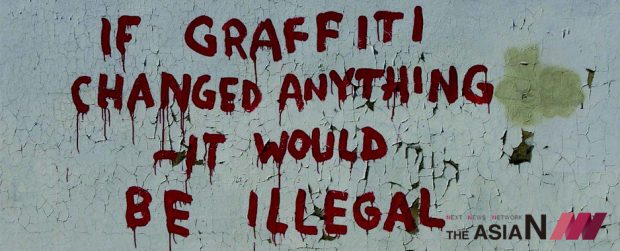“Think outside the box, collapse the box, and take a fucking sharp knife to it”: How Artists Describe the World
Back in 2010, when Banksy, an anonymous England-based graffiti artist and film director, visited San Francisco, his work popped up in various neighborhoods. A curator, Brian Greif, had taken off a part of the wall that had Banksy’s graffiti to preserve it; he looked for a museum that accepted the piece and since then, has been shared with the public. What Grief did was in stark contrast with what Stephen Keszler, an art dealer, had done with Banksy’s work—excavating the art from public sites and then selling them for personal gain, all without the artist’s permission.
Colin Day’s documentary, Saving Banksy, discusses such matters about Banksy’s graffiti analyzing the conflicting philosophies surrounding the street art movement. Without concluding the right or wrong-ness of street art preservation, the documentary shares with audiences Banksy’s artistry and his personal way-of-thinking. Interestingly, the artist is famous for his political activism: in his graffiti, Banksy touches on the various political and social themes of anti-war, anti-consumerism, anti-fascism, anarchism, and existentialism. He highlights hypocrisy, greed, poverty, and despair, once involving himself in the narration of the conflict in Gaza. In his video titled, Make This the Year YOU Discover a New Destination, Banksy raised his voice on the negative consequences of the Israeli bombings. “If we wash our hands of the conflict between the powerful and the powerless, we side with the powerful—we don’t remain neutral,” he wrote on a still standing wall in Gaza.
Then, in 2015, Banksy opened a grotesque theme park, Dismaland, parodying the innocence of Disneyland and critiquing capitalism, the establishment and its abuse of power. A Cinderella-castle where visitors steer miniature boats packed with desperate refugees spilling over the hulls, a pumpkin chariot—crashed, reminiscent of Princess Diana’s tragic car crash, and a riot police vehicle transformed into a waterslide ride; just a few of the dismal creations by 58 artists that stood inside Dismaland for five weeks.
Banksy, without a doubt, freely criticizes many aspects of the society we live in. But this function of art as social criticism is not new or even, rarely seen. During the Neoclassical period (18th-19th centuries), artists vividly portrayed political scenes in their artwork. Jacques-Loui David’s famous painting, The Death of Marat, focused on the murder of French revolutionary leader Jean-Paul Marat. In his interpretation, T. J. Clark, an art historian, described the painting as the first modernist painting because of “the way it took the stuff of politics as its material and did not transmute it.”
During the Romantic period (1770-1848), both Eugene Delacroix, who painted Liberty Leading the People, and Théodore Géricault, who painted The Raft of the Medusa, depicted inequality amongst the social classes. And in the 1950s, realism art brought to light Honoré Daumier, a French printmaker, painter, and sculptor who by painting his The Third-class Carriage, visualized a cramped, dirty, open compartment lined with hard benches with people who could not afford better tickets.
Various realism movements were also seen such as in Italian neorealist cinema. Known as the Golden Age, neorealism appeared as a national film movement characterized by stories about the poor and working class. In their films, Directors the likes of Vittorio De Sica, Federico Fellini, Alberto Lattuada, Roberto Rossellini, Luchino Visconti, Giuseppe De Santis, and Cesare Zayattini frequently used non-professional actors to express the difficult economic and moral conditions of post-World War II Italy.
“You live and you suffer” was a line in the film Bicycle Thieves (spoken by Antonio Ricci, the main character), which tells the story of an unemployed man struggling through the economic depression of Italy. Antonio finds a job hanging up posters, but for that he needs his bike—that someone has stolen. He and his son look for the bicycle, but when they manage to locate the thief, they have no evidence to accuse him. Keenly aware that he cannot work with his bike, Antonio himself becomes a thief. Bicycle Thieves represents “poverty’s authentic sting: banal and horrible loss of dignity. Bicycle Thieves is a brilliant, tactlessly real work of art” (The Guardian). Directed in 1948 by Vittorio De Sica, the movie received an Academy Honorary Award two years after in 1950, a sign of Italian neorealism having given voice to the victims of society and cinematic art as its critical tool.
Sometimes, using art as an instrument of social criticism or for satirical purposes may come with bad results. For instance, for his influential artwork, Chinese artist Ai Weiwei was jailed numerous times. Although he has gained a network of supporters in the international arena, he experienced persecution in his homeland. In 2010, Ai Weiwei covered the floor of the Turbine Hall at Tate Modern in London with over 100 million handmade replica sunflower seeds. Each seed was molded, fired, hand-painted, and fired again the Chinese city of Jingdezhen over a two-year period.
“Like Ai Weiwei’s other works, Sunflower Seeds was a work closely related to the society, politics and economy in China. It alludes to the globalization and mass production in China that caters to western consumerism, and to the deemed insignificant element at the bottom of the production chain—thousands of cheap labors, assembly lines in gigantic factories, and tedious procedures,” as explained on the artist’s personal website. The sunflower seed, a common Chinese street snack shared by friends, and the material—porcelain—one of China’s most prized exports, together they speak as a powerful narrative of the human condition.
Over the centuries, art has claimed many roles including religious narration, storytelling, items of pure aesthetic, entertainment, and so on. But is there anything more meaningful or useful than art as social commentary to stir the human conscience?
Alessandra Bonanomi, reporter for The AsiaN
























































